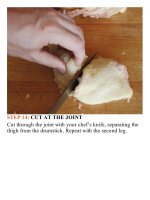The food lab better home cooking through science ( PDFDrive ) 51
Bạn đang xem bản rút gọn của tài liệu. Xem và tải ngay bản đầy đủ của tài liệu tại đây (64.83 KB, 2 trang )
servedifferentpurposes.Herearethemainfeatures
ofmostknives:
• TheCuttingEdgeisthesharpened,honededgeof
the blade. It should be razor sharp—a wellsharpened knife will literally be able to take the
hairs off your arm (don’t try it). Chef’s knife
blades come in varying degrees of curvature,
designedforvarioustasks,suchasslicingorrockchopping.
• The Back, or Spine, is the long side opposite the
sharpblade.Thisiswhereyouholdyournon–knife
hand when rocking the knife back and forth for
rapid mincing. It can also be used as a makeshift
benchscraperformovingpiecesoffoodaroundon
your cutting board (you should never do this with
thecuttingedge—it’lldullit).
• TheTipisthesharppointattheendoftheblade.
It’susedprimarilyforprecisionwork.
• The Heel is at the bottom of the blade. In many
Western-style knives, the metal thickens
significantlyattheheel.Thisistomakeiteasierto
griptheknifeusingthebladegrip(seehere).
•TheBolsteristhepartofthebladethatmeetsthe
handle. It is thick and heavy, providing a good
balancing point for the blade and the handle. In a
well-balanced knife, the center of mass should be
somewhere near the bolster, so that you can rock
theknifebackandforthwithminimaleffort.
• TheTang is the extension of the blade that runs
through the handle. It provides balance as well as
sturdiness.A knife with a full tang (that is, metal
thatextendstothebuttofthehandle)isunlikelyto
everloseitshandle.
• The Handle is where your whole hand rests if
usingthehandlegrip,orwhereyourthreesmaller
fingers rest if using the blade grip (which I
recommend). Handles can be made of wood,
polycarbonate, metal, or various exotic materials.
I like the feel and grip of a real wood handle, but
thereisnorightorwronghere.
•TheButtisthefattenedsectionattheverybottom
ofthehandle.
THETWOGRIPS
T
hefirststeptoperfectknifeskillsislearninghow
toholdaknife.Therearetwobasicgrips:thehandle
gripandthebladegrip.









